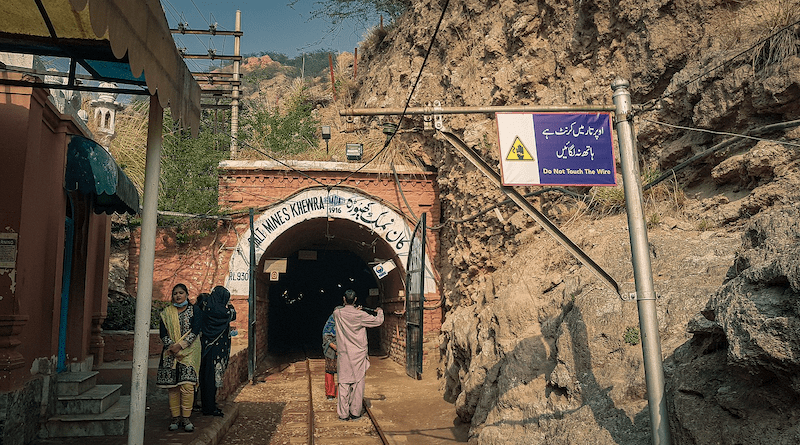Mining In Pakistan:Towards Climate-Proofing Projects – Analysis
By Institute of South Asian Studies
By Isha Gupta and Imran Ahmed*
Mining is a key source of income for Pakistan, given its enormous mineral deposits spanning an area of 600,000 square kilometres. Pakistan possesses the world’s second-largest salt mines and coal reserves, the fifth-largest copper and gold reserves and the second-largest coal deposits. Additionally, the country has abundant gravel, sand and limestone deposits spread across all four provinces. Minerals are crucial in construction, manufacturing, energy supply and agriculture, among others.
Nevertheless, if not properly restricted and regulated, mining has the potential to inflict severe damage on the environment, leading to pollution, deforestation and disruptions to the delicate ecosystem. Therefore, it is crucial to strike a balance between promoting economic growth and preserving the integrity of the environment. Extensive deliberation on this matter took place during the proceedings of the civil petition (No.55 of 2022) before the Supreme Court of Pakistan, presided over by Justices Syed Mansoor Ali Shah and Ayesha A Malik. The court’s judgement shed light on this issue, providing a comprehensive analysis and examination of the subject matter. The petitioners, in the public interest, contested the lack of sufficient environmental approvals regarding the issuance of licences or leases for small-scale mining.
Section 12 of the Environmental Protection Act of 1997 requires that all projects need environmental approval from the Environmental Protection Agency. The focus of concern in the civil petition case lies in the issuance of small-scale licenses or leases for mining minor minerals such as sand, gravel and sandstone, with little regard for the potential environmental consequences. An agreement was reached on 27 December 2019, stipulating that the Mines and Minerals Department (MMD) submit Initial Environmental Examination (IEE) and Environmental Impact Assessment (EIA) reports for every project. Additionally, it was mandated that environmental approval be obtained prior to the initiation of the bidding process and the issuance of the offer letter to a successful bidder.
Thereafter, based on Section 33 of the Act, the Punjab Environmental Protection (Review of Initial Environmental Examination and Environmental Impact Assessment) Regulations were promulgated dated 16 December 2022. As stated in the judgement, “as per these Regulations, projects listed in Schedule-I(D) require an IEE which include commercial extraction of sand, gravel, limestone, clay, sulphur and other minerals not included in Schedule-III and with a total cost of less than US$500 million (S$677.4 million). It also includes the exploration of coal, gold, copper, sulphur and precious stones. Similarly, projects listed in Schedule-II(C) require an EIA which includes mining and processing of coal, gold, copper, sulphur and precious stones.”
The regulations explicitly outline the necessity of conducting an IEE or an EIA, which serve as crucial measures in preventing environmental harm. These assessments can encompass a range of standards and initiatives aimed at enhancing sustainability within the sector. They also include provisions for implementing mitigation measures and establishing monitoring protocols through the implementation of an Environmental Management Plan (EMP). While the regulations did not specify a clear timeline, they did specify what must be done before the bidding of the project commences and suggested that the MMD set up standard operating procedures and penalties in case of violations of the EMP.
In a broader context, Justice Malik concluded that the utilisation of IEE and EIA processes is essential in promoting sustainability and mitigating the adverse environmental effects associated with mining. The paramount concern of climate change – a significant global threat – is further compounded when coupled with surface mining, posing substantial risks to ecological balance. Consequently, it becomes imperative for the mining industry to adopt a climate-resilient mining policy that considers the potential repercussions of climate change on mining areas. The mining sector can effectively tackle this urgent issue by incorporating climate change risks into environmental assessments. As stated by Justice Malik, “There is huge potential in the mining sector for the country’s economy; however, it cannot be achieved at the expense of the environment.”
The environment and the economy are inextricably linked, such that damage to the environment often causes damage to the economy, be it immediate or in the long run. Pakistan bears a disproportionate impact of climate change in contrast to its small emissions, highlighting the urgency of prioritising adaptation measures. As said by Martin Raiser, the World Bank’s Vice President for South Asia, “accelerated climate actions can protect the economy from shocks and secure more sustainable and inclusive growth in Pakistan.” The 2022 heatwaves and devastating floods serve as a stark reminder that climate change-triggered catastrophes can significantly hinder Pakistan’s development goals and its ability to alleviate poverty. These disasters have resulted in thousands of fatalities and displaced millions. The extent of damage to infrastructure, assets, crops, and livestock has been enormous, amounting to over US$30 billion (S$40.6) in economic losses.
The recent Pakistan Country Climate and Development Report by the World Bank Group emphasises the need for fundamental shifts in the country’s development trajectory and policies, calling for substantial investments in climate adaptation and resilience measures in the coming years.
*About the authors: Ms Isha Gupta is a research intern at the Institute of South Asian Studies (ISAS), an autonomous research institute in the National University of Singapore (NUS). She can be contacted at [email protected]. Dr Imran Ahmed is a Research Fellow at the same institute. He can be contacted at [email protected]. The authors bear full responsibility for the facts cited and opinions expressed in this paper.
Source: This article was published by the Institute of South Asian Studies (ISAS)

